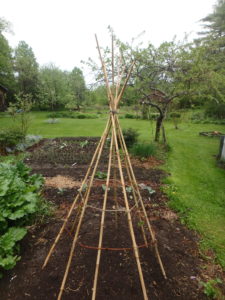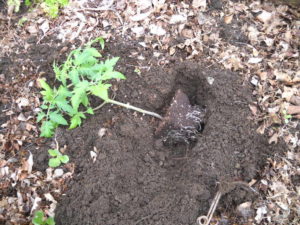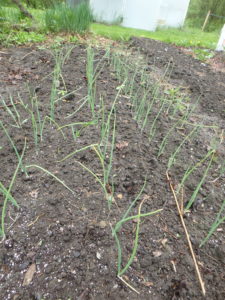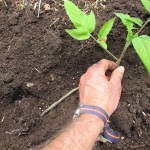It’s About Time to Plant the Vegetable Garden
One of the highlights of my year is planting my vegetable garden. It’s a time full of hope and anticipation as I nestle seedlings into the soil and sow seeds. I started many seeds indoors, growing tomatoes, peppers and more under lights. They are the right size now to plant.
Traditionally, Memorial Day weekend is the time many New Englanders plant things that are frost-sensitive. I prefer to plant tomatoes, peppers, squashes and other cold-adverse plants in June, even up to mid-June. I find that it’s better to wait until the soil really is well-warmed, and nights are warm, than rushing to plant. A night in the mid-thirties won’t kill your tomatoes, but it does set them back a bit. I find that tomatoes planted in June easily catch up with tomatoes planted earlier.
Of course, I have already planted some plants that don’t mind cold weather: lettuce, kale, onions, Brussels sprouts, broccoli and lettuce. These went in the ground in early May and are well established by now.
I built a nice bean teepee while waiting for summer to arrive, and will plant some Kentucky Wonder pole beans around it. I’ll wait until after any chance of frost has passed, as beans are frost-sensitive. I like pole beans because they keep on producing beans for many weeks if picked regularly. Bush beans produce beans for about 2 or 3 weeks, then are done.
To build the bean teepee I prepared a plot about 5 feet square, removing weeds and adding some compost. I had purchased 8 bamboo poles, each 7 feet tall. With one hand I held the poles together near their tops- say a foot from the top – and with the other I splayed out the bottoms of the poles one at a time. I tried to place the poles evenly, about 20 inches apart on the ground.
This project would be easier with 2 people working together, but I was alone in the garden and got the teepee made. I used a 2-foot length of thin copper wire to wrap around the place where all the poles crossed near the top of the teepee. String would also work fine.
In order to stabilize the teepee I then ran a string around each pole about 4 feet off the ground. I made sure the string was snug and then tied it to each pole using a clove hitch I learned in the Boy Scouts eons ago.
I did a second loop around the teepee with a flexible piece of grape vine, weaving in and out between poles, and then tying the vine to each pole with a short piece of string. I used grape vine because I had some, and I liked the way it looked, but you could stick with string if that is all you have.
When the time comes to plant my tomatoes I will take steps to ensure their roots develop well. Often tomatoes I start get long and “leggy” by the time I’m ready to plant. If I just planted the root ball, those tall stems would flop over. But I can convert that long stem into a root-bearing portion of the plant by burying it.
This can be done either by burying the root ball about 6 inches deep in a raised bed, or by planting the stem sideways. In either case I snip off the lower 2 to 4 branches, leaving leaves just at the top of an 8 to 12 inch stem.
To plant a tomato sideways, I dig a hole for the root ball and a trench for the stem. The top I bend and turn up, so those leaves are above the soil line. I cover the stem and root ball with soil, and I’m all done. You might fear you will break the stem when bending it, but that has only happened to me once in many years.
When planting tomatoes, don’t crowd them! Fungal diseases are a real problem most years, but can be minimized if the plants get good air circulation and lots of sunshine.
“Harden off” your tomatoes (and all plants) before putting them out. Ask at the garden center if the plants have been hardened off. If they’ve been in a greenhouse and never been outside in the sun, you’ve got to get them used to the sun. Greenhouse plastic reduces the sun’s ultraviolet rays and also protects plants from dehydrating in the wind.
If you buy plants that haven’t been hardened off and really, really want to get them in the ground, remember this: if you sunburn your plants, or dehydrate them, you will lose 2 weeks of growing time. You won’t kill them, but they will sulk. So don’t plant this weekend if the plants you buy aren’t hardened off.
Here’s how I harden off my tomatoes: I put them out for morning sun on my north-facing deck for 2 to 3 days, then in afternoon sun for 2 to 3 hours for a couple more days. Then they go out in the garden all day and night in their pots. Finally, I plant. I water the plants each day so they won’t dehydrate.
Gardening should be fun. It’s most fun when everything works and you harvest great vegetables. Don’t rush to get your plants in the ground, keep them well watered, and you should do just fine.
Follow Henry’s blog posts at https://dailyuv.com/
June in the Vegetable Garden
I know gardeners who rush to get their veggies in the ground, starting spinach and peas in April, carrots, potatoes and more by mid-May and then tomatoes and all the rest by Memorial Day weekend. Not me. I’m just planting many things. Sure, my peas, planted in May, are about a foot tall. And all my root crops – beets, carrots, kohlrabi, leeks, onions and rutabaga are up and looking good. Let’s look at some other vegetables.
Organic corn seeds, the type I buy, are not treated with fungicides and so they might rot if planted in wet, cool ground – and that describes the type of soil I have right now. So here’s what I do: I plant them in “plug trays”. Mine are plastic trays with 98 growing compartments per flat, each a bit deeper than the standard 6-packs I use for starting veggies in flats. I fill the holes with a 50-50 mix of potting soil and fine compost and plant one seed in each.
Corn takes 10-14 days to germinate in cold, wet soil. Last year, the first time I grew corn in many years, my corn germinated on a heat mat in 3 days! I let it grow for a week or so, allowing the roots to fill the soil compartments of my plug trays and develop true leaves.
Then, on a hot sunny day in mid-June, I planted the corn seedlings in the field. It was quick work for two people: I crawled along on my hands and knees, planting corn every 8 inches; my partner, Cindy slipped the plants out of the flat and handed them to me. We allowed 30-36 inches between rows. If space is a constraint, you can plant rows 24 inches apart, but the ears will be smaller. In order to get good pollination, you must plant in blocks with at least 4 rows.
Crows are the bane of corn growers. They love the corn seeds that have just germinated and have some small leaves. By planting good-sized plants, the corn is less vulnerable. It only takes a day or so for the roots to develop the strength to resist crows, and the germinated seed is long gone.
A wise gardener who direct-seeds her corn told me that she sprinkles fresh grass clippings around her corn when it first germinates. The greenery disguises the seedlings, fooling the crows. She does that twice, allowing the corn to be well settled in. Slick!
June 10 is my usual day for planting tomatoes, though I’ve planted later, and the plants catch up quickly. I plant tomatoes deeply, or sideways. That way the long stems become shorter and less floppy, and the buried stems develop roots, providing more roots to absorb water and nutrients.
To plant sideways, dig a hole for the rootball and a trench for 6 inches (or more) of stem. Pinch off all the lower leaves and branches, just leaving the top leaves. Cover the rootball and stem, and turn the top up. The series of photos below shows each step.
This year I am not adding any fertilizer in the planting hole. Usually I add some bagged, slow-release organic fertilizer in each hole. But reading Carol Deppe’s book, The Tao of Vegetable Gardening, last winter convinced me that too much fertility encourages tall plants but less fruit. Maybe I’ll do some each way and see for myself.
The vine crops – cukes, zukes, winter squash and pumpkins – would be badly munched by striped cucumber beetles unless I take preventive actions. The dastardly beetles and eat the new cotyledon leaves in a single night! So now I start them in small pots indoors, and let them develop foot-long vines before I put them out.
I also cover my vine crops with Reemay or row cover when I plant them to keep those beetles off. I don’t bother using wire hoops to keep the Reemay off the plants, I just lay it down and pin the edges to keep it from blowing away. But I have to remove it when the plants flower, as they are insect pollinated. By then the plants are big enough to survive. Row covers are good for keeping flea beetles off broccoli, too.
Potatoes can be planted in May – or now. I plant in June, in part, because my soil is near a stream and is colder and wetter than many other gardens around. But I also do it so that the Colorado potato beetle will go to my neighbors’ potatoes instead of mine (sorry, Lois). That’s right, they will be munching away on the neighbor’s potatoes before mine even go in the soil.
I plant lots of beans, in part because they freeze so well that I can store them and eat them all year. I plant beans in mid-June when the soil is plenty warm – 65 degrees or more, and when nights are warm, too.
Nights in the 40’s or low 50’s are very discouraging for warm-season crops like peppers, beans and tomatoes. Egggplants hate chilly nights. You can place a dark-colored rock the size of a melon near each eggplant, and it will soak up heat during the day and kick it back at night. I do that for peppers sometimes, too.
Gardening is a dance I do with the weather, the birds and the bugs. Sometimes I get great harvests, other times I do not. Still, I consider myself blessed to have a plot of good soil, an amenable climate, and the good health to pull the weeds! I wish the same for you!
You may e-mail questions to Henry at henry.homeyer@comcast.net. His website is www.Gardening-Guy.com. His book, The New Hampshire Gardener’s Companion, is just out in an expanded 2nd edition.








